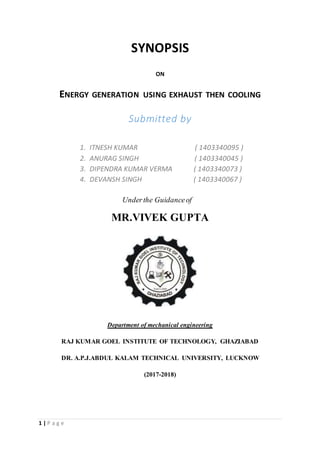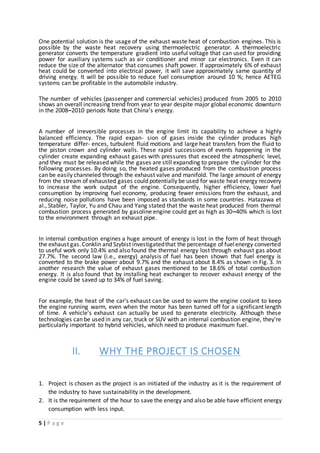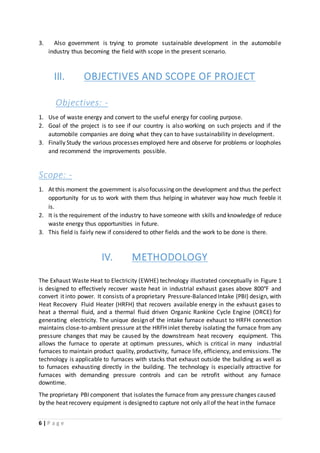The document outlines a project that focuses on recovering waste heat from internal combustion engines to generate electrical power using a thermoelectric generator (TEG). It discusses the methods, objectives, and scope of improving energy efficiency in automobiles by converting exhaust heat into usable energy, thus promoting sustainability in the automotive industry. The successful implementation of the proposed system demonstrates its potential to enhance power generation capacity while minimizing environmental impact.


![3 | P a g e
ABSTRACT
A number of irreversible processes in the engine limit its capability to achieve a highly
balanced efficiency. The rapid expansion of gases inside the cylinder produces high
temperature differences, turbulent fluid motions and large heat transfers from the fluid to
the piston crown and cylinder walls. These rapid successions of events happening in the
cylinder create expanding exhaust gases with pressures that exceed the atmospheric level,
and they must be released while the gases are still expanding to prepare the cylinder for the
following processes. By doing so, the heated gases produced from the combustion process
can be easily channeled through the exhaust valve and manifold. The large amount of energy
from the stream of exhausted gases could potentially be used for waste heat energy recovery
to generate power. Various methods to harness the waste heat to produce power effectively
had ended up in vain. This project implements a thermoelectric waste heat energy recovery
system for internal combustion engine automobiles, including gasoline vehicles and hybrid
electric vehicles.The key is to directly convert the surface heat energy from automotive waste
heat to electrical energy using a thermoelectric generator (TEG), which is then regulated by a
DC-DC Cuk converter to charge a battery using maximum power point tracking. Hence, the
electrical power stored in the battery can be maximized. The experimental results
demonstrate that the proposed systemcan work well under different working conditions, and
is promising for automobile industry.
I. LITERATURE REVIEW
Even a highly efficient combustion engine converts only about one-third of the energy in the
fuel into mechanical power serving to actually drive the automobile. The rest is lost through
heat discharged into the surroundings or, quite simply, leaves the vehicle as “waste heat”.
Clearly,this offers agreat potential for the further reduction of CO2 emissions which the BMW
Group’s engineers are seeking to use through new concepts and solutions.
The current research is focusing on a technology, which is able to convert the thermal energy
contained in the exhaust gas directly into electricpower. Taguchi [1] invented an exhaust gas-
based thermoelectric power generator for an automobile application. In this invention, the
exhaust gas gases in the pipe provide the heat source to the thermoelectric power generator,
whereas the heat sink (cold side) is suggested to be provided by circulation of cooling water.
An experimental study was conducted at VIT [2] wherein a heat exchanger with 18
thermoelectric generator modules was designed and tested in the engine test rig. This study
revealed that energy can be tapped efficiently from the engine exhaust and in near future
thermoelectric generators can reduce the size of the alternator or eliminate them in
automobiles.
A typical total waste heat recovering technology, using thermoelectric generators (TEGs),
coupled with a gasoline engine was investigated in this study conducted at Ambrose Alli
University, Nigeria [5]. According to the experimental analysis conducted by Suryawanshi et](https://image.slidesharecdn.com/energygenrationusingexaust-180507170910/85/synopsis-Energy-genration-using-exaust-3-320.jpg)
![4 | P a g e
al. [6] the temperature of pipe surface of exhaust gases flowing through exhaust gas pipe is
very high and it is around 2000C to 3000C so a heat exchanger is made, which conducts heat
from exhaust pipe to thermoelectric modules, one surfaceof these modules is in contact with
the surface of hot side heat exchanger and other is in contact with the surface of cold side
heat exchanger and thus potential difference is created and power is produced due to See
beck effect.
Baskaret al. [7] did an experiment to study and analysethe feasibilityof retrofitting the waste
heat recovery system to a two-stroke petrol engine. The experimental performance testing
has shown that the overall efficiency of two stroke petrol engine installed with and without
the waste heat recovery systemis 29.67% and 29.2% respectively when the power extraction
was 90W. Jadhao et al. [8] in his paper had analysed the possibility of heat recovery from an
IC engine and the various ways to achieve it. He has compared the various possibilities like
the Thermo electric generation, Thermo Ionic Generation and Piezoelectric Generation. He
found that in Thermo Electric generation, optimal temperature difference is sufficient to
produce the required power.
Birkholz et al. [9] have implemented the same TEG principle to recover the heat and to
generate power, but the material they used was FeSi2. Yu and Chau [10] has proposed and
implemented an automotive thermo-electric waste heat recovery system by adopting a Cuk
converter and a maximum power point tracker (MPPT) controller into its proposed systemas
tools for power conditioning and transfer. They reported that the power improvement is
recorded from 7.5% to 9.4% when the hot-side temperature of the TEG is heated from1000C
to 2500C. Also, when the hot-side temperature of the TEG is fixed at 250 0C, the power
improvement as much as 4.8% to 17.9% can be achieved.
In recent years the scientific and public awareness on environmental and energy issues has
brought in major interests to the research of advanced technologies particularly in highly
efficient internal combustion engines. Viewing from the socio-economic perspective, as the
level of energy consumption is directly proportional to the economic development and total
number of population in a country, the growing rate of population in the world today
indicates that the energy demand is likely to increase. Substantial thermal energy is available
from the exhaust gas in modern automotive engines. Two-thirds of the energy from
combustion in a vehicle is lost as waste heat, of which 40% is in the form of hot exhaust gas.
The latest developments and technologies on waste heat recovery of exhaust gas from
internal combustion engines (ICE). These include thermoelectric generators (TEG), Organic
Rankine cycle (ORC), six-stroke cycle IC engine and new developments on turbocharger
technology. Being one of the promising new devices for an automotive waste heat recovery,
thermoelectric generators (TEG) will become one of the most important and
outstanding devices in the future. A thermoelectric power generator is a solid-state device
that provides direct energy conversion from thermal energy (heat) due to a temperature
gradient into electrical energy based on “Seebeck effect”.
The thermoelectric power cycle, charge carriers (electrons) serving as the working fluid,
follows the fundamental laws of thermodynamics and intimately resembles the power cycle
of a conventional heat engine.](https://image.slidesharecdn.com/energygenrationusingexaust-180507170910/85/synopsis-Energy-genration-using-exaust-4-320.jpg)



